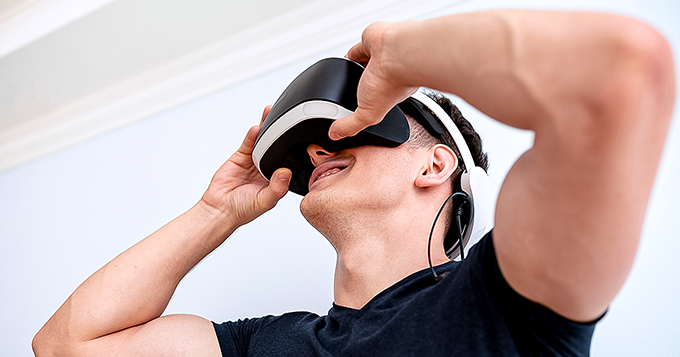
Digital technology breakthroughs have driven the fitness industry’s dramatic shift over the past ten years. Thanks to the integration of digital platforms and smartphone apps, we now approach exercise in a completely new way, more accessible, individualized, and entertaining than ever. Fitness can be achieved more successfully and joyfully with the help of these digital tools, which recognize and address individual demands.
The transition to digital fitness solutions has been significantly hastened by various factors, with the global pandemic being the most influential. This unprecedented event has compelled many to explore alternative ways to maintain their fitness from the safety of their homes. As a result, there has been a notable increase in the creation and use of fitness platforms and applications that meet various demands. These include social networking features encouraging user community, AI-driven workout plans, and virtual personal training.
In the future, technology and fitness will continue to blend together, increasing the fun and excitement of exercising. Upcoming trends such as wearable technology, artificial intelligence, virtual reality, and sustainable fitness practices are set to define the next era of fitness experiences. These innovations will enhance workouts’ effectiveness and make fitness more enjoyable and engaging, ensuring that it seamlessly integrates into our increasingly digital lifestyles.
1. Rise of Personalization in Fitness
The shift to highly customized experiences is one of the main trends influencing the future of fitness. As consumers become more health-conscious and data-savvy, the demand for tailored workout plans, nutrition guidance, and fitness routines has surged. This change is mostly brought about by the realization that no two people are alike; different people have different body types, levels of fitness, lifestyles, and personal objectives, all of which significantly impact what works best for them.
The trend towards personalization in fitness is only expected to grow. We can anticipate more precise and tailored fitness solutions as AI and data analytics become even more advanced. Integrating data from several sources—such as wearables, health records, and even genetic information—will allow for unparalleled customization, resulting in fitness routines that are as unique as the people who follow them.
2. The Integration of Wearable Technology

Wearables like smartwatches and fitness bands have evolved from basic step counters to advanced health devices that track various metrics. These devices easily integrate with fitness applications and offer real-time information on stress levels, heart rate, and calories burned. This integration allows users to adjust their workouts dynamically based on their performance and physiological feedback.
We can expect even greater integration with fitness apps as wearable technology advances. Future wearables may offer more detailed biometric data, such as muscle oxygenation and hydration levels, providing even deeper insights into physical performance. Moreover, developing more sophisticated algorithms will allow wearables to deliver even more personalized and actionable feedback. These advancements will make workouts more effective and enhance the overall health monitoring capabilities of fitness platforms, further blurring the lines between fitness and healthcare.
3. Social Connectivity and Community Building
The rise of social connectivity and community building within fitness apps has transformed the way people engage with their fitness routines. Fitness is no longer a solitary pursuit; it’s increasingly becoming a social experience where users can connect, compete, and support each other. This shift has been fueled by integrating social features within fitness platforms, making working out more interactive, motivating, and enjoyable.
Future apps may leverage advanced social networking features, such as more personalized group recommendations or AI-driven social interactions that connect users with similar goals or interests. Additionally, integrating virtual and augmented reality could make social fitness experiences even more immersive, allowing users to work together in virtual environments that mimic real-world settings.
These developments will further blur the boundaries between virtual and real-world fitness communities, facilitating user connectivity, competition, and mutual support wherever users may be. This trend towards social connectivity enhances the user experience and underscores the importance of community in achieving long-term fitness success.
4. Virtual and Augmented Reality in Fitness

Virtual reality (VR) and augmented reality (AR) are quickly becoming revolutionary technologies in the fitness industry. They offer immersive and interactive experiences that are redefining the way people exercise. These technologies are not just enhancing traditional workouts; they are creating entirely new ways for users to engage with fitness, blending the boundaries between the physical and digital worlds. As VR and AR evolve, their impact on the fitness industry is expected to grow, making workouts more engaging, accessible, and effective.
One potential development is integrating biometric data into VR and AR workouts, allowing the technology to adapt to the user’s physical state in real-time. For instance, a VR workout could adjust the difficulty level based on the user’s heart rate or fatigue, ensuring the session remains challenging yet safe.
Another exciting possibility is the expansion of social VR and AR experiences, where users can work together in shared virtual environments regardless of their physical location. This could include virtual group classes, team-based fitness games, or virtual marathons where participants worldwide can compete in real-time. These social experiences would make fitness more engaging and help build communities around shared fitness goals.
Furthermore, as AR technology improves, we might see more sophisticated applications that integrate with everyday life, turning ordinary activities into fitness opportunities. For example, AR could transform a daily walk into an interactive adventure with fitness challenges or overlay workout instructions directly onto gym equipment, providing real-time guidance and feedback.
5. Sustainability and Eco-Friendly Fitness Trends
As awareness of environmental issues grows, sustainability has become a key focus in various industries, including fitness. Eco-friendly methods and materials in workout routines demonstrate a more significant commitment to sustainable living and environmental stewardship. Fitness enthusiasts and companies increasingly seek ways to reduce their ecological footprint while maintaining their health and wellness goals. This trend reshapes the fitness industry by introducing more sustainable practices and promoting environmental consciousness.
Future developments include advanced eco-friendly materials for fitness products, such as biodegradable or upcycled materials, and more comprehensive carbon footprint tracking features within fitness apps. There may also be increased technology integration to support sustainability efforts, such as smart equipment that monitors and reduces energy consumption or apps that facilitate virtual workouts to reduce travel-related emissions. Additionally, partnerships between fitness companies and environmental organizations could lead to more initiatives to promote personal and planetary health.
Trainest: The Future of Fitness

Trainest represents a groundbreaking approach in the fitness app industry. It aims to offer an all-in-one solution that addresses the core pillars of fitness– nutrition, check-in, workouts, and progress. Focusing on integrating diverse features into a cohesive platform, Trainest stands out by providing users with a comprehensive suite of tools to enhance their fitness journey. Experience the benefits of a unified fitness solution—download Trainest now and start transforming your workout routine with our all-in-one app.
Key features of Trainest include:
• Nutrition: Trainest understands that nutrition is crucial to fitness. It includes a comprehensive nutrition tracker that helps users customize meal plans and track their food intake and macros. The app also offers nutritional information to help users make healthier food choices.
• Check-In: Trainest includes regular check-ins and goal-setting features to keep users engaged and accountable. The check-in feature allows users to track body metrics, enable progress photo uploads, set reminders, evaluate their progress, adjust goals, and reflect on their achievements.
• Workout: Trainest offers customizable workout programs, from strength training and cardio to flexibility exercises. Users can access personalized workout plans tailored to their fitness level, goals, and preferences. The app provides video demonstrations with detailed instructions to ensure users get the most out of their workouts.
• Progress: Trainest’s progress tracking feature enables users to monitor their fitness journey in detail. The app monitors several parameters, including body measurements, fitness objectives, and workout performance. Graphs and reports allow users to see their progress, which keeps them motivated and enables them to make well-informed changes to their routines.
Explore the Trainest website today and discover how we’re shaping the next generation of fitness apps.